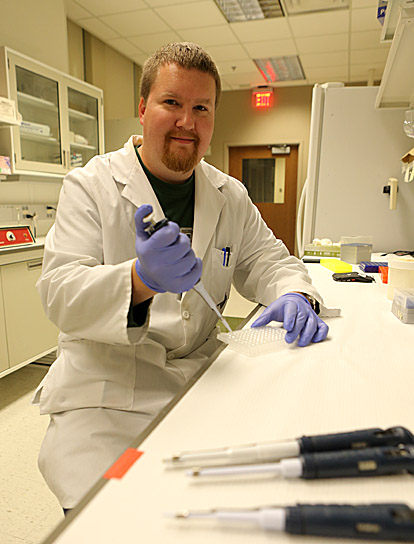Of Americans 50 and older, osteoporosis affects 55 percent and diabetes 20 percent, at an economic cost of billions, but one research group may be a step closer to a solution for both.

Dr. Lance Stechschulte sets up a real-time polymerase chain reaction plate to detect the expression of target genes.
“To me, it’s an excellent thing to be able to share my work,” he said. “Not only will everybody know what I’m working on, but it allows other colleagues to share their perspectives on my work to advance the projects. It also helps to come up with new ideas.”
Lecka-Czernik’s research group looks at PPARγ, a nuclear receptor in the human body that regulates fatty acid storage, glucose metabolism and bone mass. Stechschulte’s two abstracts focused on two different proteins that regulate PPARγ activity — protein phosphatase 5 (PP5) and FK506-binding protein 51 (also called FKBP51).
The findings of his research are that when one of these proteins is missing, the result is higher bone mass, better insulin sensitivity, and reduced adiposity or fatness.
“The idea is that when you decrease PPARγ activity causing fat development, it increases osteoblast activity, and you have higher bone mass,” Stechschulte said.
The lab Stechschulte works in uses knockout mice — genetically engineered mice in which researchers have inactivated or “knocked out” an existing gene by replacing it or disrupting it with an artificial piece of DNA. In this case, the proteins FKBP51 and PP5 have been altered.
These mice were developed by Dr. Edwin Sanchez, UT professor in the Department of Physiology and Pharmacology, and Dr. Weinian Shou, professor in the Department of Pediatrics at the Indiana University School of Medicine.
“The knockout mice, they have almost zero body fat — and this is also seen in the bone marrow,” Stechschulte said. “Fat tissue metabolism is linked to bone homeostasis. Fat in the bone may have a negative effect on bone turnover and it may cause decreased bone quality and increased incidence of fractures.”
Researchers also have found that the PP5 knockout mice have higher energy expenditures and move around more. The mice without protein FKBP51 have higher energy expenditure and move around less compared to wild-type mice.
“As far as we know, they’re perfectly healthy,” Stechschulte said. “They’re lipid-lean, they are protected from obesity, they have higher bone mass, and they have better insulin and glucose tolerance. These are two interesting models.”
Stechschulte said that his research and other similar studies also might have an impact on treatment of diabetes.
“Bone homeostasis is also being connected to the regulation of diabetes as well, as the bone can signal to other tissues,” he said. “A lot of the same factors involved in bone regulation also are involved in regulating other tissues — for example, adipose tissue.”
Stechschulte began his research in this area as a PhD student at UT in the lab of Sanchez, looking at FKBP51. Now as a postdoctoral fellow, he looks at the effect of FKBP51 and PP5 proteins on bone with Lecka-Czernik.
Both professors are in the Center for Diabetes and Endocrine Research. Stechschulte’s research is supported by a grant from the American Diabetes Association awarded to Lecka-Czernik.
Stechschulte plans to continue his research and eventually become a faculty member.